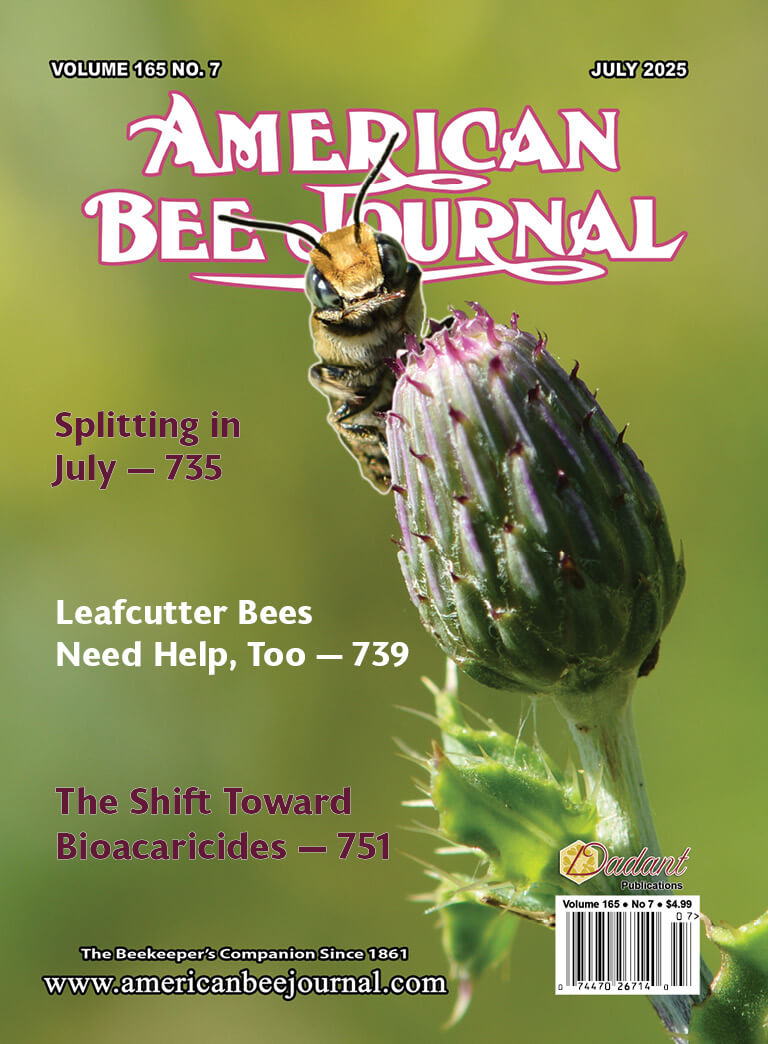The Classroom
The Classroom – July 2025

Q: Nectar, honey and wax
I am curious about how much “comb” is equal to the 7 lbs. (3.2 kg) of honey equaling 1 lb. (0.45 kg) of wax. I am thinking that if I am selling honey for $12 a lb., and I get a full deep [super] drawn, it seems like a good tradeoff. If I am selling nucs and/or rotating out old frames, I would like to know what a frame of drawn comb calculates out to in dollar value.
Ray Johnson
New Jersey, April
A
You are in luck! I happen to know this answer because my team and I calculated it for research purposes. (Please pardon any rounding errors in the math that follows here.)
Through various measurements, we were able to calculate that the average cm2 of two-sided comb (i.e., cells on both sides of the foundation) contains about 0.37 g of wax (this will vary by comb age and use). The standard deep Langstroth frame has ~883 cm2 of two-sided comb. Thus, the average deep Langstroth frame contains ~327 g (0.72 lbs.) of wax. Based off your 7 lb. (3.2 kg) of honey to produce 1 lb. (0.45 kg) of wax estimate (which is squarely in the middle of what I see folks say online), 7 lbs. of honey would produce about 1.4 deep frames of comb. The average 10-frame deep of combs contains about 7.2 lbs. (~3.3 kg) of wax, meaning it takes ~50.4 lbs. (22.7 kg) of honey to produce the wax needed in a single deep Langstroth box containing ten frames. At your $12 per lb. of honey sell rate, it took the bees $605 of honey to make the wax in the ten deep frames, or ~$60.50/frame.
Of course, the actual amount of wax in a deep comb will vary, as will how much honey it took to make it. The latter depends on the sugar and water content of the honey in question. Also, to follow this math, we should be charging $84 per lb. of wax, just to get back the value of the honey it took to make that lb. of wax. Yikes! Incidentally, this is why it is so important to protect the wax in honey supers when the supers are in storage/not being used to produce honey. There is significant honey cost to the bees (and to you!) to replace the comb in your boxes. Throw in the frame, nails, wood glue, foundation, and labor, and a deep Langstroth frame is quite valuable! Freakonomics. 😊
Q: Fainting queens
I caught my new queen to mark her. [When I put] her back on the frame, she was lifeless. She just fell over on her side and did not move anymore. I watched her for at least 30 seconds, nudging her with my finger. As the workers came to attend to her, she still never moved! So, I thought “well crap, I just killed my new queen.” So, I left her in there with hopes that her pheromones would keep workers from laying. I ordered a new queen that I found out will be here tomorrow. I decided to go get the queen out of the hive in case the bees had not tossed her out yet. Well, the queen lives and she is laying like crazy! Have you ever seen or heard of anything this crazy? Do queen bees pass out or play opossum? Please let me know your thoughts.
Eric Castleberry
Georgia, April
A
I have heard of this behavior. This is perfectly normal. Queens can “play possum” when they are stressed. It reminds me of fainting goats. Not all queens do this, but some do. In fact, when I started reading your email, I said to myself, “I bet he is going to tell me that the queen came back to life,” and this is exactly what you said!
I suspect this is a self-defense mechanism. I wonder, for example, if this comes in handy when two queens are battling. Maybe one plays dead once the other gets the upper hand, and then she springs back to life once she catches a breather. Regardless of how/why they do it, this behavior often surprises the beekeeper who sees it for the first time.
I found a neat description of the behavior in Roger Morse’s and Kim Flottum’s 1997 edition of “Honey Bee Pests, Predators, and Diseases.” In Chapter 18, entitled “Variations, Abnormalities, and Noninfectious Diseases,” Nicholas Calderone and Kenneth Tucker write:
Catalepsy in Queen Bees
Queens rarely faint, but they have been observed to do so by beekeepers who have handled large numbers of queens. This condition has been called catalepsy (Brunnich 1922), epilepsis (Laidlaw and Eckert 1962), fainting (Miles 1922), or shock (Latham 1922). When it happens, it occurs just after a queen is picked off the comb by her wings. According to Latham (1922) the queen hooks her abdomen by the last sternite with a hind leg, pulls the tip of the abdomen forward, then stiffens momentarily, next becomes motionless for a few minutes, and then gradually revives, and returns to normal activity. Not every queen who hooks her abdomen is so affected, but Latham believed it most likely in large queens with enlarged abdomens that are laying heavily. In [Miles’] (1922) experience, catalepsy happened only to young queens; moreover, most of the cases described by Brunnich (1922) were also young queens. In some cases, the queen does not revive, and death results (Miles 1922). The cause of catalepsy is unknown, but may result from a temporary nervous disorder.
I could not find anything more modern than this excerpt. I bet there is much more to the story. I hope to contribute to that story someday.
Calderone, N.W., Tucker, K.W. Variations, Abnormalities, and Noninfectious Diseases. In. Roger A. Morse and Kim Flottum, eds.) Honey Bee Pests, Predators, and Diseases. A.I. Root Company, Medina, Ohio, USA. 401 – 423/
Q; Honey storage in the brood chamber
I am based in the south of England. I have a colony in a 14 × 12 national [hive] with a super with drawn comb. The colony is backfilling the brood box rather than the super and there are few eggs in the brood box. I am interested in this behaviour but have failed to find much research about it. I am interested to know: What are the drivers for this behaviour? Does the queen stop laying and the workers backfill [the brood area] or is it the other way around? Do different bees act differently (i.e., genetics)? Why would they not use the super? How do they decide where to store nectar? Is there anything in my husbandry that could be causing this and likewise anything that could change the behaviour?
Stefan Nahajski
England, May
A
I have seen this happen many times. We call this being “honey bound.” I have asked related questions myself, but with only speculation guiding my answers. Thus, I took the liberty of emailing Dr. Tom Seeley. He is an expert on “the hive as a honey factory.” From Professor Tom Seeley:
My best guess for why your bees are putting honey near the brood nest in your hive, rather than in the honey super, is that the bees are having difficulty keeping their home warm, so are focusing their presence and their work (including the honey storage) in the region of your hive that NEEDS to be kept warm, the brood nest.
I love his suggestion that heating needs could be dictating honey storage. I am currently planning research associated with hive thermodynamics. This is not my area of expertise, so I am working with Dr. Derek Mitchell from Leeds University to address this issue. During my interactions with Derek, I have become convinced that hive thermodynamics really matter in the life of the occupying colony. Given that, I can easily see how heating issues could influence colony storage of honey, as Tom suggests.
On top of that, my team and I see this a lot in Florida. In fact, I was just discussing your observation with our laboratory manager, Chris Oster. Chris manages our teaching apiary. Temperatures are routinely in the 90s Fahrenheit (32°C or higher) and the bees are making honey. Yet, many of our colonies are storing it in the brood box rather than the supers. Internal hive temperatures possibly play a role.
It is also possible that it has to do with convenience. Maybe during a quick flow, it is easier for nectar receiver bees to place the incoming nectar close to the nest entrance so that they can get back to the entrance to offload the next incoming nectar forager. Maybe the bees have not acclimated to the super. Based on Tom’s answer and my supposition, this sounds like a question for which there are no definitive answers. Honestly, this behavior frustrates me because it is so much easier to get to the honey when it is stored in the super. …


